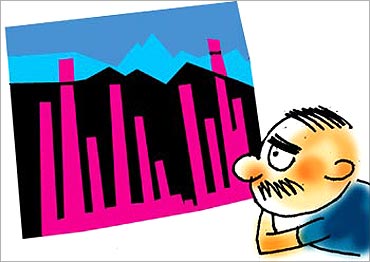 | « Back to article | Print this article |
Return in shortest time not the best goal
When asked to choose an investment avenue, most people opt for the one promising the highest returns in the shortest time frame. But, returns need not be the only solution to investment.
One needs a more practical approach to investing or managing finances. By running behind the highest returns, other important factors get ignored. Let us look at some of these.
Investing for what?
Investment instruments are means to achieve certain investment goal for the future. If you have no defined goal(s), you will be investing aimlessly. First, you should define your future goal(s) and then allocate resources optimally towards these.
Like, if you invest in an equity-linked saving scheme (ELSS, a tax-saving fund) of mutual funds just for saving taxes, in all likelihood you will withdraw it at the end of the mandatory three-year lock-in period.
But, if this is a part of your allocation towards a particular goal, say retirement, you may keep it longer, ensuring better returns and higher corpus. Closer to retirement, you may reinvest this in a debt product which offers stable returns.
Click NEXT to read further...
Return in shortest time not the best goal
And, at the end surrender their policies at a loss. If you have clear goals in mind, you will stop chasing returns and optimise investments.
Risk?
Risk and return go hand in hand. The returns will be low if the risk is low or negligible. In cases of higher perceived risk, the returns offered will be higher.
Companies with less than impeccable records usually offer a higher return on their fixed deposits, as compared to companies with an established record. The question to be asked here is whether you are willing to risk your principal to earn higher interest.
In cases of high returns being projected, look at the underlying asset to see if this is possible over the tenure of the product.
For example, when unit-linked insurance products were launched, not many understood the concept. These were then mis-sold by agents as products giving high returns in a short period of time.
Investors did not realise that the product was market-linked and hence came with associated risks. When the markets fell and returns turned negative, they felt cheated.
Click NEXT to read further...
Return in shortest time not the best goal
To generate a return, there has to be some risk taken. Is the return generated due to smart investment decisions or excessive risks? This can be judged by looking at the Sharpe ratio of the funds.
X fund may give 15 per cent return and Y fund 12 per cent, but Y may be better by taking less risk taken to produce the return. The higher the Sharpe ratio, the better the risk-adjusted returns. This can help decide between funds in a peer group.
Product tenure?
Does the tenure of the product match your financial goals? If not, you may not have the money when you need it.
Longer tenures in debt and equity products have different connotations. In debt, if you do not intend to hold the product till maturity, a longer tenure means more risk.
This is specifically because debt products are interest-rate dependent. With an upswing in the interest rate, your low interest rate paper will fetch a lower price in the market if you decide to sell it. If the interest rates fall, your high-returns paper will fetch you good.
This risk will be negated if you intend to hold the product till maturity. You will get what has been promised to you (of course, depending on the company's credit-worthiness).
In the case of equity, it is seen that over longer tenures, the risk becomes negligible. So, if you have long-term goals, beyond seven years, it is a good idea to have an equity-heavy portfolio.
Click NEXT to read further...
Return in shortest time not the best goal
Many high return products, like mutual fund or Ulips, have a regular investment need. This is applicable for long-duration traditional insurance plans, too.
For the salaried individuals, it is easier and better to opt for these. If you run a business, income flow is not constant.
Some months might be better than others. In such cases, it is necessary to ensure smooth cash flow to match the commitments.
They can have a strategy where they can invest the surplus in good months into liquid funds, from where they can avail funds by way of a systematic transfer plan facilitated by mutual funds.
In effect, they are averaging their cost and having a chance of better returns in the long run as they withdraw at different market level.
In products like Ulips, a committed investment over longer periods of time is required to show returns. It is necessary to understand that discontinuing your premiums after short periods will not give good yields.
So, you should have the capacity to pay the premiums over the entire policy duration, else this product is not for you.
The writer is a certified financial planner





